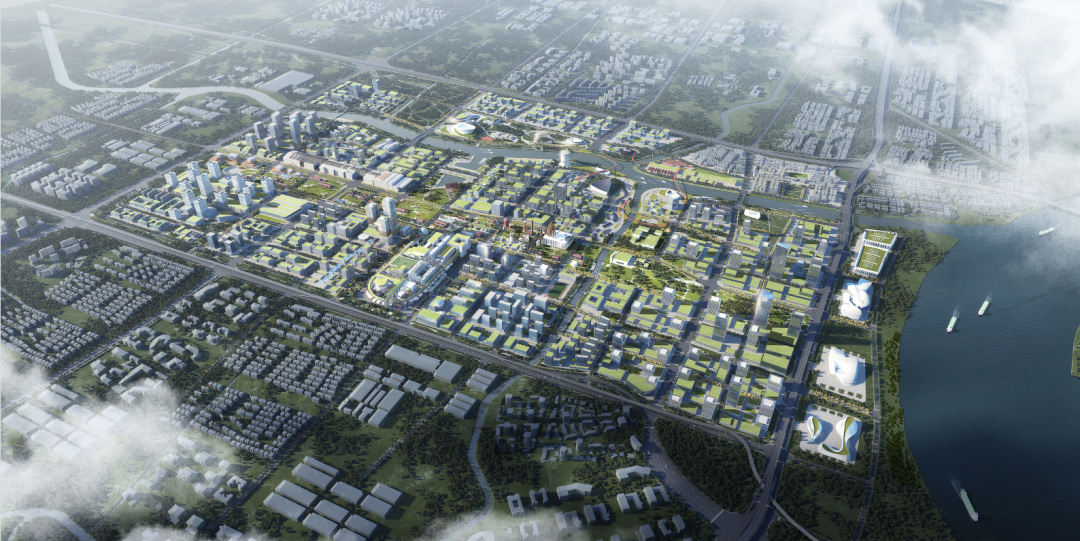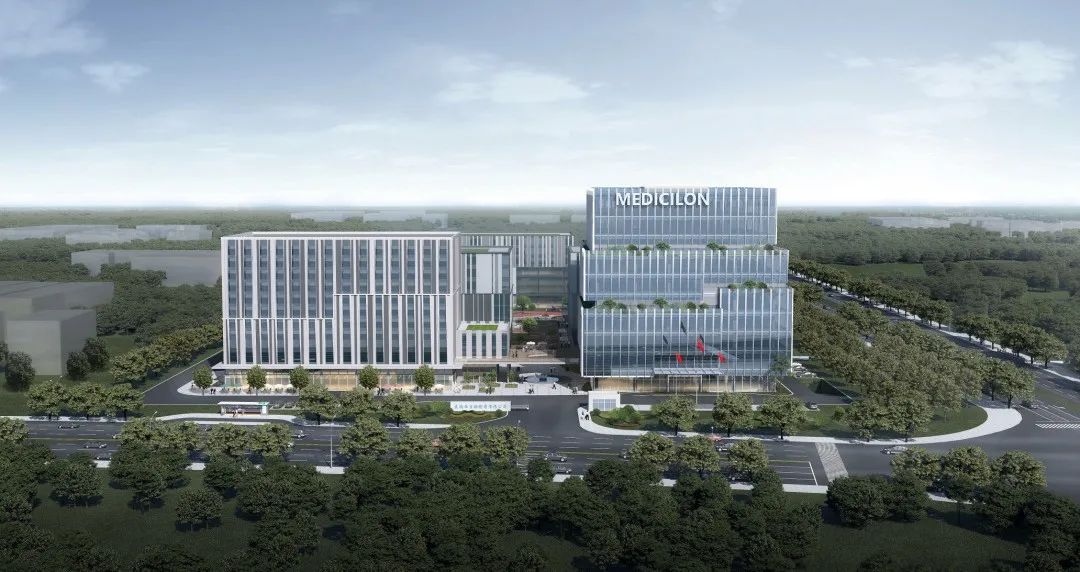Work Hard for the Realization of Northern Transformation and Make Achievements on the New Journey
On July 15, 2022, the Global Promotion Conference for the Transformation and Development of Baoshan District in Shanghai was held at the Golden Hearth • China Baowu Steel Convention and Exposition Center. The Action Plan for Baoshan District to Realize Northern Transformation and Make Unremitting Efforts to Develop Itself into a Core Component of Shanghai Scientific and Technological Innovation Center was released at the Conference. The promulgation of the Plan signifies that a mission statement, roadmap, and timetable were prepared for the strategy of “North Transformation” and the strategy has entered a period of accelerated implementation. Spread by word of mouth, the plain commentary of “Baoshan will succeed in realizing North Transformation”, which appeared in the promotion film played at the Conference, became a catchphrase for the people to express their expectations and confidence in the development of the District.
The implementation of the “Northern Transformation” strategy elates the officials and the masses in Baoshan District. After the “Southern Transformation and Northern Transformation” strategy was elevated to be an important component of the strategy of creating a new spatial pattern specified in Shanghai’s 14th Five-Year Plan, the 12th Congress of the CPC Shanghai Municipal Committee made other arrangements, requiring the District to accelerate the improvement of its functions, develop itself into a core component of Shanghai Scientific and Technological Innovation Center, and build a model area of green and low-carbon transformation. Baoshan District, which has overcome numerous challenges, has ushered in a historic moment of remarkable development during the process of carrying out arduous explorations to seek transformation paths to forge ahead in the new era.
“Major platform, main urban area, and model area”—The Implementation Opinions on Accelerating North-South Transformation and Development Implementation defines the main thread of the development of “Northern Transformation”: Efforts should be devoted to building Baoshan District into the major platform boasting active innovation entities, abundant innovation talents, outstanding innovation functions, and excellent innovation ecosystems to support Shanghai Scientific and Technological Innovation Center, the main urban area of a modern, innovative and eco-friendly international metropolis, as well as the model area of the city’s green and low-carbon transformation.
“This is another historic opportunity for Baoshan District after the founding of the Baosteel Group in the early days of reform and opening-up. If we seize the chance, we’ll win the initiative,” said Chen Jie, Chief of the CPC Baoshan District Committee. According to Chen Jie, after entering the new stage of development, the District must quicken the pace of transformation, raise the level of transformation, improve the mechanisms for transformation, activate the momentum of transformation, focus on the integration of “sci-tech innovations + the city”, as well as build itself into an important node for Shanghai to serve and impact the northern wing of the Yangtze River Delta and a new growth point for economic development in northern Shanghai.
Improve functions: Highlight “two functions” in the implementation of China’s national strategies.
Improving the core urban functions requires us to take a long-term perspective, accurately anchor development positioning in the intersection coordinates of history and the era, and set shared targets that inspire the people. To this end, Baoshan District hooks its “small gear” to the “large gear” of China’s national strategy, benchmarks against Shanghai’s “four functions”, and focuses on enhancing the functions in nurturing sci-tech innovations and propelling high-end industries. Developing the District into a high-level “core component of Shanghai Scientific and Technological Innovation Center” is the principal pulling force that integrates key functions and drives comprehensive functions.
Higher education and research institutes are the sources of scientific and technological achievements, while enterprises are the key force to industrialize those achievements. The focus of the strategy of building Baoshan District into a core component of Shanghai Scientific and Technological Innovation Center is the transformation and industrialization of scientific and technological achievements. That requires us to tap the resources such as locations and spaces, industry foundations, history, and cultural heritages, integrate and develop unique comparative advantages, open up and shorten the links from the R&D ends to the industry ends, and cultivate and create whole-chain innovation and incubation ecosystems teeming with “innovations”. To this end, Baoshan District, with an open mind of using resources of external parties rather than possessing all the resources, gave full play to the higher education institutes and businesses in the District, built a “One Core and One Belt” University Science Park Cluster, and constructed “model rooms” for the coordinated transformation between central enterprises and the local government of the District.
Baoshan District is improving its innovation ecosystems by constructing university science and technology parks and forming an alliance of university science and technology parks. Apart from the Science and Technology Park around Shanghai University and the Baoshan Fudan Technological Innovation Center supported by local universities, the District has cooperated with several distinguished domestic and foreign universities, including Peking University, Huazhong University of Science and Technology, University of Shanghai for Science and Technology, and Sydney University of Science and Technology, to develop science and technology parks. From January to July this year, 102 corporations settled in university science and technology parks in the District; 23 achievements from biomedicine, intelligent manufacturing, new materials, and other industries were transformed; and a number of achievements are waiting to be transformed.
Professionals do professional matters. To promote the transformation and industrialization of scientific and technological achievements of higher education institutes, Baoshan District established University Science & Technology Park Shanghai Baoshan Development Co., Ltd., a platform company managed by the State-owned Assets Supervision and Administration Commission of Baoshan District. As an important functional member of the B-link science and technology ecosystem, the Company works as a “broker and partner of transformation of scientific and technological achievements”, offers services to high-quality projects throughout their life cycle, and provides “soft services” and “hard support” for building the District into a core component of Shanghai Scientific and Technological Innovation Center. The Company led eight university science and technology parks in Baoshan District to set up the alliance of university science and technology parks, which is dedicated to aiding the District to build itself into a core component of Shanghai Scientific and Technological Innovation Center. The Company explored the joint working model of university science and technology parks through practices, and better stimulated the coordinated development among university science and technology parks in the District by focusing on the sharing of superior resources, in-depth exchanges about projects, and promotion of model experience. The Company strengthened cooperation with the National Eastern Tech-Transfer Center to build the offline “digital science and technology port” and the online “Kechuangbao” platform. The Company pooled enormous innovation resources of the Center, as well as linked the demand side of enterprises, the achievement side of higher education institutes, the side of intermediary services, and the side of policy supply. Up to now, many great innovations such as China’s first 8-inch graphene wafer, first unmanned surface vehicle for Antarctic scientific research, first new alkene-carbon aluminum alloy for producing rockets, and first turbine engine for UAVs have been created in those university science and technology parks.

The industrialization of scientific and technological achievements needs policy and financial support. To this end, Baoshan District carries out the collection, selection, and reserve of pilot projects of “investing first and then holding shares” in the university science and technology parks in the District. Each year, a special fund with a budget of RMB 50 million for pilot projects of “investing first and then holding shares” is set up in the industry support fund of the District; in principle, the supporting capital for a single project shall not exceed 50% of the total investment of the project, and the amount shall not be higher than RMB 10 million; for original core technological innovation projects, common key technologies that lead industry upgrading, and major technological innovation projects that fill domestic gaps, the maximum amount of the supporting capital can be up to RMB 20 million.
Baoshan District gives full play to the enterprises in the District. It is promoting Baowu Group and other central enterprises and state-owned enterprises in the District to conduct transformation through sci-tech innovations to become the main force for building the District into a core component of Shanghai Scientific and Technological Innovation Center. On August 8 this year, a transformation and development promotion conference was held in Wusong Innovation City. Wusong area, the former base for the steel industry is developing into a demonstration area of the transformation and upgrading of companies. A large number of central enterprises and municipal state-owned enterprises, including Baowu Group and Orient International (Holding) Co., Ltd, are implementing the “Southern Transformation and Northern Transformation” strategy, accelerating their transformation through sci-tech innovations, increasing secondary investment, utilizing their endowment advantages, coordinating the resources and strengths of all parties in a wider scope according to the priorities, timings, and models to work out new methods to bolster high-quality regional development led by the transformation of enterprises. In Wusong Innovation City, many functional projects are being constructed. Two projects of Baowu Group, each occupying an area of one square kilometer, have started construction; 12 provincial-level and ministerial-level engineering and technical centers of Fudan University have been put into use; and the 183-meter skyscraper, Shanghai Academy of Fine Arts of Shanghai University, Central Iron and Steel Park, and Baowu (Shanghai) Carbon Neutrality Industrial Park are ready to be opened.
Industry transformation: Stimulate the “basic” manufacturing industry to be upgraded to the “strategic” manufacturing industry and boost the “supporting” service industry to be upgraded to the “characteristic” service industry.
Baoshan District is replacing traditional industries with new ones. The District is resolutely taking a new path of industry transformation guided by sci-tech innovations, stimulating the “basic” manufacturing industry to be upgraded to the “strategic” manufacturing industry, and boosting the “supporting” service industry to be upgraded to the “characteristic” service industry. In recent years, the three municipal characteristic industrial parks of Shanghai Industrial Park of Robotics, Super Science and Innovation Park (New Material), and North Shanghai Biomedical Industrial Park have bolstered the coordinated development of new materials, high-end equipment, biomedicine, the new generation of information technology, and other strategic emerging industries.
Shanghai Industrial Park of Robotics, which keeps raising its standards and making room for emerging industries, has witnessed many happy events lately. In mid-August, YIBU SEMI’s project of an advanced packaging production line for producing 720,000 chips annually was launched in Baoji E Wisdom Valley in the Park, and it is expected to achieve mass production by the end of 2023. Besides, a new R&D institution, the Silicon Photonics Packaging R&D Center of SIMIC Holdings Co., Ltd., was also established in the Park. The Center is co-built by YIBU SEMI and the Chinese Academy of Sciences. The two parties will share their technical teams, equipment, facilities, and production plants. At present, integrated circuits depend on electrons to store and process transmission signals, but they face limitations. Once the silicon photonics technology is overcome, many optical and electrical components can be reduced and integrated into an independent microchip to realize high-speed optical transmission at a lower cost. YIBU SEMI focuses on advanced packaging technologies such as the Chiplet packaging technology, filling a key gap in the semiconductor industry of Shanghai.
Not far away from YIBU SEMI, the young Fermion Instruments also celebrated a milestone in its development. On September 9, Fermion Instruments (Shanghai) Co., Ltd. held the tenth anniversary of its establishment and the opening ceremony of its new site. Since its founding, Fermion Instruments has moved five times and finally settled in Shanghai Industrial Park of Robotics in 2017. Fermion Instruments, started by its three founders in a small room of about ten square meters, now hires 226 employees and owns a new site of 13,000 square meters. Fermion Instruments, which boasts a considerable number of core technologies with independent intellectual property rights in the high-end scientific research instrument industry, has created four businesses: Ultra-high vacuum technology, cryogenics technology, thin film fabrication technology, and plasma technology. The clients of its scientific research instrument include many prominent universities and research institutes at home and abroad, such as Peking University, Tsinghua University, Boston University, and Cornell University. In recent years, Fermion Instruments has been awarded the titles of a high-tech enterprise in Shanghai, a specialized and sophisticated enterprise that produces new and unique products, and a “high-tech little giant” enterprise.
In the north of Baoshan District, new developments took place in the much-anticipated North Shanghai Biomedical Industrial Park. The newly established Shanghai Innovative Vaccine Technology Park gathers many high-growth companies and biotechnology unicorns, including CanSinotech SPH Biologics Inc, RNACure, BravoBio, and Abogen Biosciences, which specialize in the R&D and manufacturing of universal vaccines, tumor vaccines, and multidisease/multivalent vaccines. That reflects another important target of the District’s journey of “realizing Northern Transformation”: The District will rely on “seed players” to occupy leading positions in the vaccine manufacturing industry to accelerate its progress toward a “high-end manufacturing base and R&D innovation center for biological vaccines” under the background of Shanghai’s efforts to build a world-class biomedical industry cluster. For Baoshan District, pooling “seed players” with core technologies will provide a key impetus to improve its ecosystems for sci-tech innovations and enhance its ability to nurture sci-tech innovations. To this end, Baoshan District introduced a package of support policies to resolve the blocking points and pain points of firms to facilitate their vaccines to go to market.

The new projects embody that the cluster of innovative biomedical enterprises in Baoshan District is gaining momentum. On September 21, Shanghai Medicilon Inc’s Biomedical R&D and Innovation Industrial Base with a total investment of RMB 1.57 billion started construction. After the construction is completed, the company will build a comprehensive platform for R&D of small-molecule drugs and biological drugs, PROTAC drug R&D platform, small nucleic acid drug R&D platform, AI-guided drug design and synthesis platform, antibody-drug conjugate (ADC) R&D platform, and biological research platform, making greater contributions to the economic expansion of Baoshan District and the development of the innovative drug industry in China.
At the 2022 Shanghai Global Investment Promotion Conference, the list of the third batch of 13 characteristic industry parks in Shanghai was announced. “Nanda Digital Smart City” Industrial Park and Baowu (Shanghai) Carbon Neutrality Industrial Park are on the list. With the Shanghai Industrial Park of Robotics, the Super Science and Innovation Park (New Material), and the North Shanghai Biomedical Industrial Park being included, the number of municipal-level characteristic industry parks in Baoshan District has increased to five. Through the construction of characteristic industry parks, the District will keep advancing the high-quality development of characteristic industry parks from the three aspects of activating existing resources, increasing additional resources, and innovating variable resources, in an effort to inject impetus to build the District into a core component of Shanghai Scientific and Technological Innovation Center and start the “new engine” of high-quality development.
Spatial transformation: Develop the “two sectors” in reshaping the strategic landscape.
Located in the northern part of Shanghai, Baoshan District sits at the mouth of the Yangtze River. Focusing on the regional spatial transformation, the District is developing the “two sectors” by making internal scientific planning and opening up the blocking points that impede its linkage with neighboring regions.
In the past, Baoshan District, located at the intersection of the three rivers, was more like a “transportation terminal” due to the restraints of objective conditions. Recently, the preliminary design of the Shanghai-Nanjing-Hefei section (Shanghai-Hefei section) of the Shanghai-Chongqing-Chengdu High-speed Railway was approved by China State Railway Group Co., Ltd., Shanghai Municipal People’s Government, Jiangsu Provincial People’s Government, and Anhui Provincial People’s Government; the Shanghai-Hefei section is expected to start construction at the end of this year. The Shanghai-Hefei section is an important part of the Yangtze River corridor of China’s “Eight Vertical and Eight Horizontal” high-speed railway network. It starts from the newly built Baoshan High-speed Railway Station in Shanghai, connects Suzhou, Nantong, Taizhou, Yangzhou, and Nanjing in Jiangsu Province as well as Chuzhou and Hefei in Anhui Province, and ends at the existing Hefei South Railway Station. The double-track Shanghai-Hefei section is 553.762 kilometers long, including 519.046 kilometers of newly built railway, and it is designed to operate at a maximum speed of 350 kilometers per hour. Baoshan High-speed Railway Station, which is planned to have eight platforms and 18 tracks, is the starting station of the Shanghai-Chongqing-Chengdu High-speed Railway and the hub station of the Shanghai-Suzhou-Nantong Railway.
After the operation of the Shanghai-Chongqing-Chengdu High-speed Railway and the Shanghai-Suzhou-Nantong Railway, Baoshan District is expected to play a greater role in the building of the Belt and Road Initiative, the development of the Yangtze River Economic Belt, and China’s strategy for integrated development of the Yangtze River Delta. The District will “receive the impact of downtown Shanghai in the south, create the cross-river linkage with neighboring regions in the north, connect to the pioneer area for socialist modernization in Pudong New Area in the east, and link with the Yangtze River Economic Belt in the west”, in a bid to accelerate the gathering of people, resources, capital, and information and build itself into a strategic node of Shanghai’s corridor along the coastline and its corridor along the Yangtze River.
Baoshan District develops its internal “sector”, focuses on the two key transformation areas of Wusong area and Nanda region, makes full of its river resources, and builds a “new countryside”.
Wusong area is the intersection of Baoshan District and downtown Shanghai. It used to be one of the most polluted areas in the city with huge volumes of exhaust gases. Through the overall transformation, Wusong Innovation City is turned into a place with the largest area, the best conditions, and the most complete supporting facilities for centralized development in Shanghai, and it will be built into a new city in Shanghai. Wusong Innovation City possesses a planned area of 26 square kilometers, where two projects, each occupying an area of one square kilometer, have started construction; the construction of a large number of projects such as Baowu (Shanghai) Carbon Neutrality Industrial Park is being accelerated. Relevant government departments responsible for collecting international urban development schemes for the nine-square-kilometer area within the Outer Ring Expressway have begun to prepare regulatory planning. The construction of landmark projects, including the Wusong Campus of Shanghai Academy of Fine Arts of Shanghai University and the TOD project of the metro station of South Jiangyang Road, is being quickened.
Known as a rare region for Shanghai’s urban development, Nanda Smart City, with a planned total area of about six point three square kilometers, is located in the southwest of Baoshan District, between the Middle Ring Road and the Outer Ring Expressway, and close to downtown Shanghai. The region was once dotted with chemical, leather, and warehousing enterprises. Since 2012, the government in charge of Nanda region has carried out a decade-long work, demolishing almost all the buildings on nearly six square kilometers of land and reclaiming the land. With forward-looking planning to boost high-quality development and attract high-tech industries, Nanda Smart City built urban infrastructure, greening projects, roads, education institutions, and medical facilities by complying with the general requirements of “not lower than the development standards for the banks of the Huangpu River” and “benchmarking against top-notch international cities”, and radically improved the urban environment of the region. With the goal of “a city above the ground, a city below the ground, and a city in the clouds”, Nanda Smart City, which boasts an excellent environment where people can enjoy their work and life, is coming into being.
The 40-plus kilometers of riverbanks of Baoshan District remained undeveloped for a long time. By carrying out the “Huangpu River and Suzhou Creek” project, Baoshan District has opened the six-kilometer demonstration section along Huangpu River starting from Wusongkou International Cruise Port and the one point forty-four-kilometer banks of No.1 Bay of Yunzaobang River, enabling local residents to enjoy themselves in the section and along the banks. Yunzaobang River, the mother river familiar to the people in Baoshan District, is becoming a popular “river of sci-tech innovations”. In the near future, the banks of Yunzaobang River, which connects Wusong area, Nanda region, and other places under transformation, will pool abundant scientific and technological elements and enterprises full of innovation vitality; the banks will develop into economic empowerment belts along the northern part of the Middle Ring Road, important practice areas for improving Shanghai’s ecology, transformation of old industrial areas, and urban renewal, as well as “show belts” in Baoshan District.
The rural landscapes in Baoshan District are beautiful. Previously, the District took the lead in Shanghai in building a 12.92-square-kilometer demonstration area for the interactive development of five villages in Luojing Town. Tapping the premium natural resources of Luojing Town, the District built a maternal and child health care base in Tangwan Village, a base producing seasonal ingredients in Yangqiao Village, a fresh vegetable base in the woods of Xinlu Village, a green rice base in Huahong Village, and a base for marine products and sports activities in Haixing Village. With the complex functions of industry, culture, and ecology, the villages not only achieved mutual development by sharing functions, but also acquired brand-new looks. As a result, new villages with high-quality development, first-class amenities, and highly efficient governance have been formed.
Transformation of governance: Improve public services, public management, and public security in multi-dimensional empowerment and efficiency enhancement.
Focusing on the target of modernizing Baoshan District’s system and capacity for governance, the District makes every effort to provide better public services, public management, and public security.
Baoshan District spares no effort to ameliorate its business environment; relevant policies and measures have been iterated to version 5.0. In early 2021, the District released ten new preferential policies for enterprises, including: Realizing “one link and issuing licenses on the same day” for starting a business; satisfying the normal business need of newly established companies to apply for invoices; adopting the approval model of granting four certificates on the same day to ensure that a project can start construction immediately after obtaining the land; carrying out early acceptance of completion of a single building of an industry project; implementing the full life cycle support policy for corporations; operating investment follow-up mechanisms for industry projects in line with development directions; innovating the standards and models for supervising firms; providing the “chief agent” service for key enterprises; launching the upgraded version of “Cherry Blossom Service Card” for top talents in Baoshan District; and fully opening public service application scenarios. These “Golden Ten” preferential policies for companies greatly facilitated them to start and grow their business in the District.
In February 2022, Baoshan District released the “Ten Innovative Measures for Improving the Business Environment in 2022”, which were upgraded from the 2021 version of relevant measures. The first measure identifies the heads of Party committees and governments in the streets, towns, and parks across the District as the first persons responsible for advancing key projects; they should implement the “chief agent” system, take the lead in communicating with companies, and coordinate to resolve bottlenecks during the promotion of key projects. Under the leadership of the Baoshan District Development and Reform Commission, the list of 133 key enterprises was drawn up, the list of services for the first batch of key projects of the “chief agents” was compiled, and several key enterprises were allocated to each chief agent. Over the past six months, the chief agents have made new moves and great efforts. They have conducted in-depth communication with the persons in charge of enterprises and cooperated with the persons in charge of industry parks to seek solutions. The chief agents offer services to companies that are not on the above-mentioned list of key enterprises. As long as persons in charge of enterprises come to meet the chief agents with requests, they will provide the best services, set up special work groups, and hold coordination meetings to overcome difficulties as soon as possible. As of August this year, 442 services have been performed by the chief agents of the streets, towns, and parks across the District. To handle the bottlenecks confronted by enterprises in a more efficient and coordinated manner, the team of “chief agents” in Baoshan District will be expanded: The heads of key commissions, offices, and administrations may be appointed as “chief agents”. They will work with the chief agents of the streets and towns in the District to observe the purpose of “answering all questions asked and giving response to every request”. Besides, Baoshan District organizes the chief agents to carry out exchanges on work, improves the working mechanisms, betters the workflows, and speeds up the formation of an atmosphere where the chief agents try their best to render first-rate services.
Baoshan District carries on expanding the scope of digital empowerment. Over the past years, the District has developed several characteristic applications based on the “One Network Service System” and the “One-stop Urban Management Network” according to its realities, such as the functions of one thing of helping enterprises go public and the intelligent assistance in quickly filling out forms provided by the “One Network Service System”, as well as the application of rural residential environment management offered by the “One-stop Urban Management Network”. “Connect Communities”, initiated by Baoshan District, is an excellent case of China’s social governance, and it was upgraded to the “Community Cloud” platform for Shanghai. The platform is available to residents in all communities across the District. Nearly 274,000 issues of the residents were solved on this platform. Over 90% of those issues were tackled by residents in their communities through self-governance and co-governance. That is a vivid embodiment of practicing whole-process people’s democracy.
Baoshan District takes the offering of inter-provincial services as an opportunity to strengthen the links between services, expand mutual recognition and interflow in education, medical care, elderly care, and social security, boost the integration of public services in the Yangtze River Delta, reduce the time spent by people in handling affairs via exchanging data, and provide more guarantees for talents coming from other places in China to settle in the District. Since the start of the reform of the “One Network Service System” for the Yangtze River Delta at the end of 2019, inter-provincial services covering 44 counties, cities, and districts in eight provinces have been created. By visiting the online platform of “Yangtze River Delta + One Network Service System” and offline special windows, sharing data, and sending express deliveries, applicants from counties, cities, or districts outside of Shanghai can easily deal with their problems in Baoshan District without traveling to those places. Based on the data matching results of provincial platforms at the current stage, the District offered a function in the Baoshan Channel of the “One Network Service System” to allow it to call 37 types of frequently used electronic certificates issued by governments of other cities in the Yangtze River Delta. At present, such electronic certificates as ID card, driver’s license, road-worthiness certificate, and business license have been called for more than 1,000 times.
Baoshan District enjoys limitless potential for economic development. After two years of sustained efforts, the District has made remarkable progress in sci-tech innovation. To realize “Northern Transformation”, Baoshan District will unswervingly implement the new development philosophy and focus on industry transformation to coordinate the spatial transformation and transformation of governance. The District will build itself into the main force of green and low-carbon transformation and development through holistic and systematic transformation, a model district of the transformation of traditional industrial areas, a ballast for the real economy, and a new engine for economic and social development, so as to provide a solid support for Shanghai to better help build the new development paradigm of China.

宝山汇APP

上海宝山微信

上海宝山微博